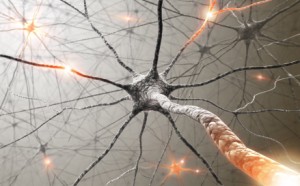 Previous posts discuss how the new science of neuroplasticity replaced the former, static model of the brain. But, research is just now uncovering the inner workings of the incredibly active neuron.
Previous posts discuss how the new science of neuroplasticity replaced the former, static model of the brain. But, research is just now uncovering the inner workings of the incredibly active neuron.
Repairing A Very Long Wire
If we consider relative size, a human cell is smaller in comparison to a human, than a human is to Mt. Everest. Despite their very small size, some neurons build and maintain an axon that travels two feet from the cell body in the spinal cord all the way to the foot, or the finger where it stimulates a muscle or it senses touch. This relative distance is equivalent to a human walking along the wall of China while building and maintaining the entire structure.
Any breaks in this astoundingly long wire, if not repaired, can cause severe nerve pain, known as neuropathy. To perform these repairs, the neuron builds tracks out of tubular proteins, which act as the highways of transportation for restorative materials. Originating at the nucleus near the center of the cell, these newly constructed materials traverse the tubular proteins, to reach the area in need of repair.
Very Rapid Manufacture and Transport
 The neuron also must manufacture and transport other materials to both the axon and the dendrite. It sends signal chemicals, called neurotransmitters, as well as the material to make the sacs that hold and then release the neurotransmitters into the synapse. The process whereby the sacs are loaded, docked near the membrane, fused with the membrane to release the chemicals into the synapse, and then reabsorbed, all without any breaks in the membrane, involves very complex machinery.
The neuron also must manufacture and transport other materials to both the axon and the dendrite. It sends signal chemicals, called neurotransmitters, as well as the material to make the sacs that hold and then release the neurotransmitters into the synapse. The process whereby the sacs are loaded, docked near the membrane, fused with the membrane to release the chemicals into the synapse, and then reabsorbed, all without any breaks in the membrane, involves very complex machinery.
Many of the neuron’s 100,000 dendrites change size daily in response to the neuron’s varying needs for communication with other cells. This necessitates the constant transport of new scaffolding materials to build new emerging dendrites. Dendrites also need to manufacture and transport the large complex protein receptor molecules, which sit in the membrane and are triggered by the signals from other cells.
Decision Making Process

While all of this activity is proceeding, another complex process determines when the neuron will send its signal to the next cell. We don’t fully understand how a neuron decides to trigger a signal but it appears to be based upon an analysis of the inputs from the 100,000 other cells sending incoming signals. The decision to send a response is at least partially based on factors such as the spatial arrangements and pulsation rates of incoming signals. There is some evidence that neurons make individual decisions and that two neurons might not send the same signal given the same input.
New Neurons

Another complex feat is the creation and integration of new neurons in the brain’s memory and smell centers. After a stem cell divides and produces a new neuron, the new cell travels a considerable distance, somehow finding its appropriate place in the brain where it establishes connections with existing cells, budding axons and dendrites.
Where is the direction for this astonishing level of rapid complex activity in this individual cell that responds in an instant to any mental activity? Does the remarkable neuron show signs of mental behavior?